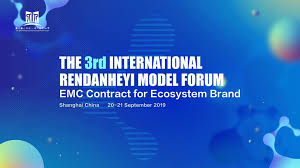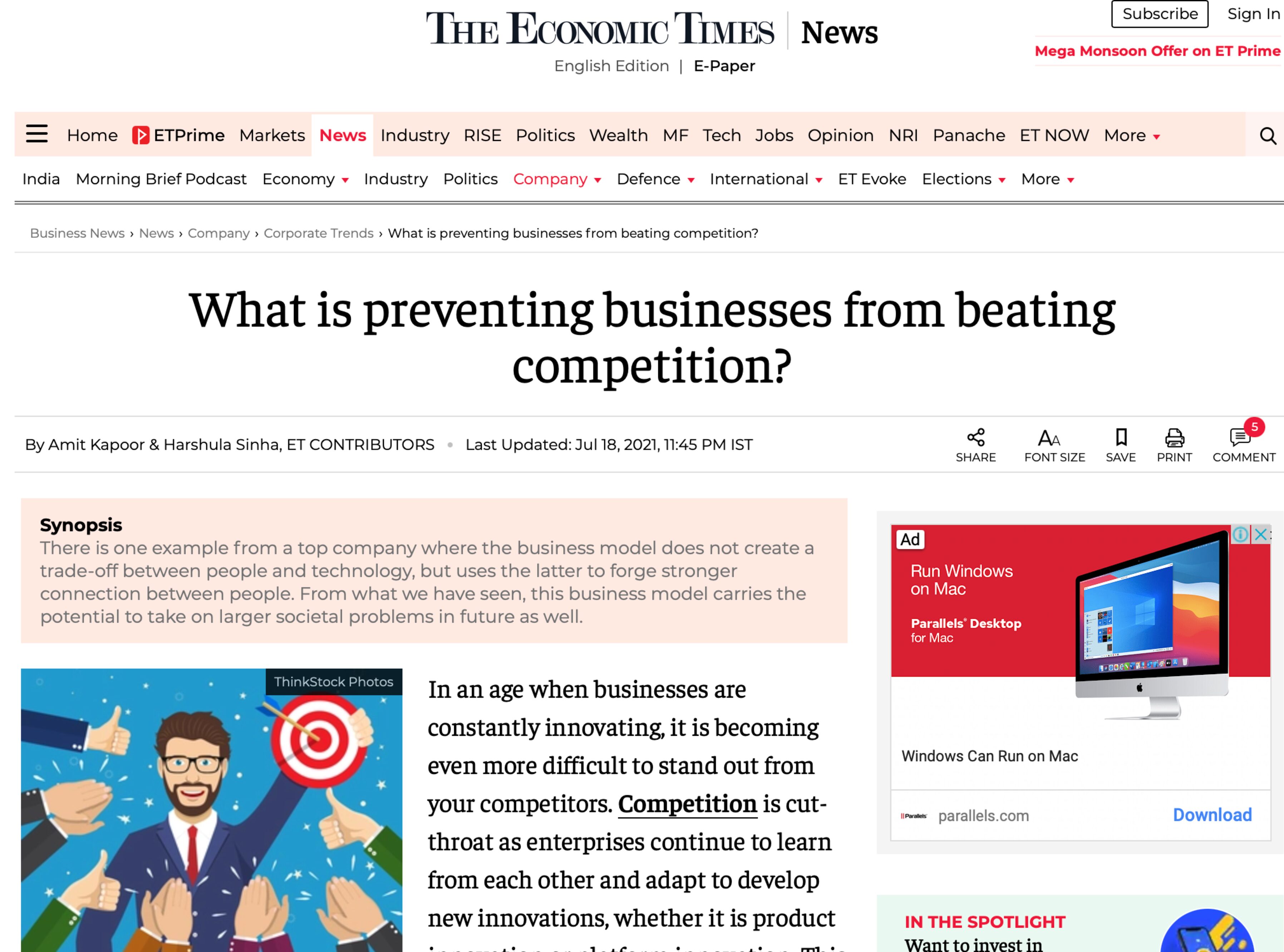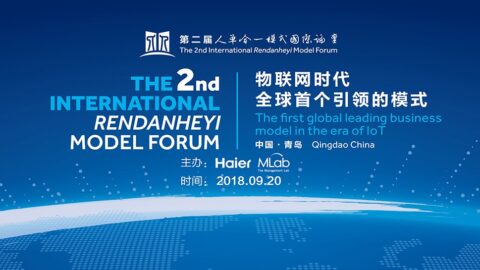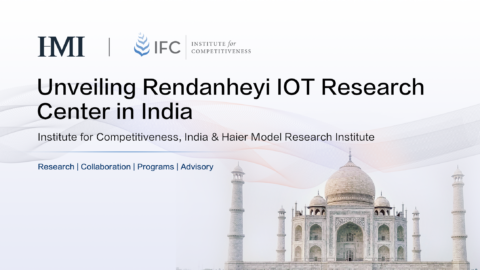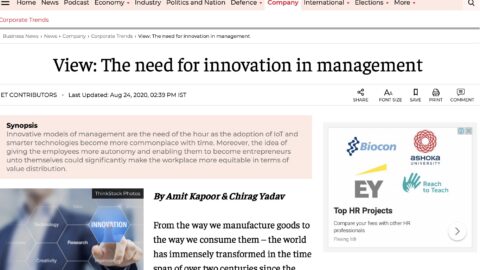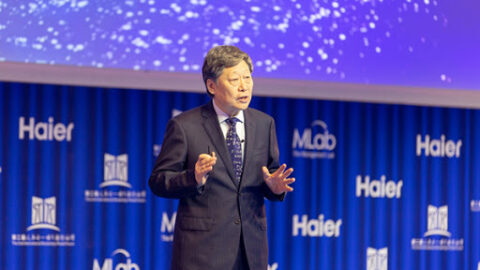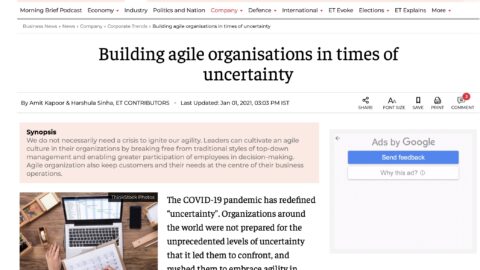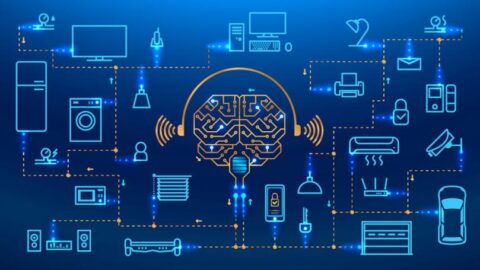All rivers return to the ocean
-Creating a win-win situation for EMCs
Based on CEO Zhang’s speech for the 3rdInternational Rendanheyi Model Forum
The title of my speech is “An ecosystem where all Ecosystem Micro-communitiesthrive”, which refers to a new paradigm of the Rendanheyi Model. The “Ecosystem Micro-community(EMC)” is a unique idea proposed by Haier; it is an ecosystem chain where microenterprisesand microenterprise partners create user experience iteration together. The Haier ecosystem chain is made of over 4000 microenterpriseswith numerous partners, and all microenterpriseson that chain are called Ecosystem Micro-Communities (EMC).
Yesterday I visited the No.001 experience center of Haier Smart Home. This center offers experience or scenarios, instead of products. Within just one month after its grand opening, over 1000 potential partners had reached out to this center with offers of partnership. These types of partnerships would allow all parties to create and share value together, ultimately generating a win-win situation.
01 The trinity: a logical progression
My speech has 3 parts: creative destruction, creative reorganization and creative leading.
Creative destruction means that in order to transform ourselves and better adapt to the IoTage, we must break the old rules of the industrial age, and create rules for the age of IoT. Creative reorganization means that we must build the new rules for the IoT age, now that the old rules are broken. Creative leading means that after making the new rules, we also must take the lead in the new age of the IoT.
To better explain these ideas, let me show you a picture of the triple deity of supreme divinity in Hinduism. There are thousands of deities in Hinduism, but there are only 3 main deities: Brahma the creator, Vishnu the preserver, and Shiva the destroyer. The old must be torn down in order to make room for the new; and once the new is created, it needs to be protected by a guardian in order to grow. Each of the three deities is an indispensable part of the triple deity; they are inseparable, and they also form a logical progression.
The EMC Chart is a strategic framework for Haier’s transformation towards the age of IoT: it provides guidance for creative destruction, and frameworks for creative reorganization and creative leading. We can analyze the chart from 4 dimensions: self-organization, self-driven, self-value generation and self-evolving.
Self-organization. The horizontal axis is solution EMCs, such as traditional R&D and manufacturing; the vertical axis is experience EMCs, which would pass the user opinions to solution EMCs: the two types of EMCs work together to generate user needs. Experience EMCs are social communities and touch points, which directly interact with users; traditional companies do not have experience EMCs. In traditional companies, once the products are manufactured, they are delivered to distribution channels or e-commerce channels for sales; and the interaction between company and users end at the point when products are delivered. But for us, this is just the beginning. You can see in the chart the two half-circlesgradually move toward each otherand converge, forming a complete circle atthe end. This complete circle is the ecosystem, and it looks very much like the Yin and Yang symbol in traditional Chinese culture. Yin and Yang are opposite sides of things, and they fight with each other, just like the R&D department and the sales department in traditional companies: they blame each other for the failures in product sales.
Self-driven. Solution EMCs and experience EMCs are bothmicroenterprises, so how are they going to work together when there is no leader? The answer is that they would have to be self-driven by the need generated byuserapplication scenarios ecosystem. I believe that the key point for IoT or 5G is scenarios. In other words, 5G and IoT are meaningless without scenarios. People have been talking about IoT for a very long time, but up till now it is still not in wide application. Why is that? The answer is that there are no scenarios here. IoT is not just a connection among sensors, but a connection between people.
Self-value generation. Userneeds change all the time; how do we motivate the EMCs to revolve around user needs? User needs change every day, and they cannot be completely satisfied. That’s when we need “self-value generation”, where solution value and experience value are combined,theadded-value created are shared among the self-organizations. In traditional companies this is impossible, because first, people have no idea how much value they create; second, these values are not delivered by themselves but by chain stores or e-commerce platforms. But when self-organizations and users are connected, people won’t blame each other when there is a loss, because every person is responsible. When added value is created, people can share it proportionally.
Self-evolving. Added-value sharing allows self-organizations to evolve together and create a win-win situation. When things are successful, people can share the value created, and they are in turn motivated to create more value, and get more shared value. There will bea limit to the value the self-organization is able to create, and by then the self-organization will have to open itself up and attract high quality resources from outside; self-organizations will have to keep optimizing itself in order to constantly satisfy user needs.
Economics is a complex domain, yetit revolves aroundtwo core issues: first, how do we generate wealth? Second, how do we distribute wealth? Economists over the years have been trying to solve these two questions. Today Haier put these two questions into one: added value sharing can create wealth and allow wealth sharing, and the two problems can be solved as one.
The concept of value chain was proposed by Michael Porter in a traditional competition setting, and it is no longer suitable to explain today’s problems. Companies have primary activities and supporting activities, both of which are led by management instead of users, and both create value that is needed by company leaders, not by the market. Also, it is difficult for different departments to work together, because they each have their own leaders. Finally, the creation and delivery of value are separated; the transaction between companies and customers is a one-time deal; and there are no users, only customers.
02 Creative destruction: Replace linear management model with an ecosystem driven by Ecosystem Micro-Communities
Traditional companies are all linear organizations, but EMCs are non-linear organizations. EMCs can reorganize among themselves based on user experiences. All companies have 3 major parts: system ofgoals, organizational structureand incentivesystem. System of goalssetsstrategic directionswhich are implemented through organizational structure, whileincentive system providesthe driving forces. In EMCs, thesystem of goalsis self-driven by user experiences, while in traditional linear management system, it is consist ofKPIs. The organizational structureof EMCs is decentralized autonomous organizations (DAO), while intraditional linear management it is hetero-organization. The incentive system in EMCs is the added-value sharing mechanism, while in traditional linear management models theincentive system is broadband compensation and golden handcuffs, which insimplewords is that compensation is determined by the company, whilein Haier it is paidby users.
Let’s look at the system of goalsfirst. There are 2 problems with traditional KPI systems: first, every department looks out for its own interest, and there is no consideration of value of the whole; as a result, one plus one is never greater than two. Second, there is no concept of user value, because there are no users, and everyone just follows the leaders in the company.
Haieradopts theself-driven system of“3 Zeros” (zero distance to users, zero delay in experience, and zero signature in process). For example, you don’t need to submit any applications or get any signatures from your manager for any new product development; as long as you have had sufficient communication with the users, and you believe that there is market needs and profit margin, you can start the project. However, you would be responsible for the risk whilesharingthe added value.
Let me share with you a case example: the Zhengzhou-Hefei EMC. The Zhengzhou EMC is an experience EMC, and it focuses on building user touch-point networks in communities in the Zhengzhou and Henanregions. The Hefei connected factory is a solution EMC, includesfunctions like R&D and manufacturing. The two EMCs work with each other, and they have the decision rights for product choices, prices and so on. In the past, Haier Group would set sales target for the Zhengzhou region, then the Zhengzhou region would let the Hefei factory know the manufacturing quantity, and finally the Hefei factory would set the manufacturing plan accordingly. The sales growth rate was always about 8%, never exceeding 10%. Now the average monthly growth rate is about 30%. This is because everybody is on the same boat now; they succeed orfail as a whole, and no one can blame others.
Next let’s talk about organizational structure. Microenterprisesmust align themselveswith communities and keep iterating. Haier Yunxi washing machine has undergone6 rounds of iteration so far, withincreased sales for each generationthan the last one, along with higher pricesandrevenue. More important, Yunxi washing machines has completelydisrupted the usual d R&Dcycleshortened it from twice a yearto two months the quickest, making iterationswhenever the users need it. In the past Haier followed Japanese, and wouldn’t release the product unless it was absolutely perfect. Now, we followSilicon Valley. Ifyour first product does not embarrass you, you are not moving fast enough. You can keep improving your product once it is launched to the market. Also you can interact with users and keep iterating.
Finally let’s look at the incentive system. The Rendanheyi Model is essentially the integration of people, goals and compensation, and the alignment of entrepreneur value and the user value created. If you can generate user value, then you are valuable, and vice versa. The traditional principal-agent incentivemechanism is now being replaced by the mechanism of acquiring equity through entrepreneur ownership. Equity is not distributed by any central power, but created by the entrepreneurs themselves. In his book Skin in the Game, Nassim Nicholas Taleb said, that the reason that modern companies have so many risks is because nobody is held responsible when something goes wrong, even if every department supposedly has its own responsibility. I’ve seen the Hammurabi Code on a basalt stele at the Louvre in France, and it statedthat if abuilding collapsedand people died for it, the architectwould have to pay with his life. Obviously, this does not work for modern companies, but it is reasonable to connect the success and failure of the company to individual employees. The Rendanheyi Model is a symmetrical model: it makes both risks and profit symmetrical.
Plato described a scene in his book Republic: the prisoners are chained so that their legs and necks are fixed, forcing them to gaze at the projections on the wall in front of them. Whoevercan foreseethe next imagewould be rewarded, and those who fail to do so would be punished. This scenario is very similar to the situation when companies try to analyze the market without knowing how the market really looks like. When a prisoner comes out of the cave, he would first be overwhelmed by the outside world, but he will get used to it quickly; he will not want to return to the cave anymore. Same for the companies, once they saw the real users, they would want tostay with the users.
There is a famous quote from Shakespeare’s Hamlet, “To be, or not to be”. If Hamlet does not seek revenge for his parents, then he will live, but in humiliation and pain. And if he does decide to seek revenge, he will almost certainly die in the process. Many companies believe that they are in a situation where seeking innovation is akin to suicide, but by not innovating, they will still slowly slide towards their eventual demise. However, seeking innovation is not necessarily suicide, but an effort to find a way out by constantly reinventing yourself. So, you need both an open mind and a strong determination. During my many speeches in business schools, many professors asked me the same question: if nobody is managing all these microenterprises, wouldn’t it be a chaotic situation? My answer is that you don’t need a manager for the enterprises, because microenterprisesare self-driven. All rivers ended up in the ocean, because they are all heading towards a same direction. What is the direction for microenterprises? It is user experience. All of us will be working towards the same goal of creating better user experience.
03Creative reorganization: 3 elements of the Rendanheyi Model
Three elements: EMC Contracts, self-driven system and added-value sharing.
First, the EMC contracts.In theory, self-organization has two requirements: 1) the introduction of negentropy, and2) the positive feedback loop. The first one refers to the introduction of new resources and players, and the second one refers to self-reinforcing-in other words, it encourages people to keep improving their work; the better they do, the more they are rewarded, and vice versa. For self-organization, they set high goals, and they require people to sign value adjustment contracts beforehand. The reward and the sharing are motivating, but people also must be held accountableif they fail to meet the set goals. The goals cannot be changed midway, and excuses such as the change in the external environment are not accepted. During the added-value sharing stage, all parties will get their sharing as stated in the contract.
In 2016 Bengt Holmström was awarded the Nobel Prize in Economics. His complete contract theory is designed to solve the problem of informationasymmetry, such as the problem of free-riders. When teams are setting reward and punishment mechanisms, sometimes it is difficult to be thorough; and if the promises are not delivered at the end, over time people would want to get free rides. The EMC contract solved the free rider problem: the mechanism and goals are set beforehand, and the promises are delivered at the end. If there is a problem midway,dynamic adjustment is allowed.
Now let’s move on to the self-driven system. We all talk about entrepreneurship. I believe that in addition to being a successful entrepreneur yourself, entrepreneurship is more about building platforms for more people tobecome entrepreneurs, because we need much more than just one successful entrepreneur. Like Schumpeter used to say, that “entrepreneurs are individuals who carry out innovative activities”, and that “entrepreneurs appear in great numbers as bees out of a hive.” Also, like Peter Drucker used to say, that “Everyone is his own CEO.”
Now let’s talk about being spontaneous and self-driven: this process is guided by creating best user experiences, and then it will attract capital from VCs, team follow-up investment and going public. Last night, Haier Biomedical was successfully listed on the STAR market. We are not a traditional medical or pharmaceutical company; we focus on IoT technology and yet, we are in the health care industry now. Let’s take U-Blood as an example. In our country, there is a great shortage of blood as a medical resource, and yet it is not uncommon to see cases of blood waste. For example, doctors receive a certain amount of blood for a surgery, and after the surgery, the unused blood is usually tossed away, because it cannot be put back into the blood bank. It is a great waste. Through IoT technology, U-Blood helps avoid such waste. This is a great example that a new speciescreated by the IoT technology: we are the first company listed on the STAR market as a technology ecosystem company.
Today we have 3 listed companies, 2 unicorn companies, 12 gazelle companies, and hundreds of companies that have received investment on Haier’s entrepreneur platform. The members of these microenterprisesare not merely order executors but entrepreneurs, and they ultimately become shareholders of their microenterprise. Haier’s HaiChuanghui is made up of start-up companies. These companies want to take advantage of Haier’s resources, so some of them offered Haier 5% or even as high as 10% of their stock, in order to be a part of the Haier ecosystem.
Entrepreneurs must have a spontaneous self-positioning as a follower, because users always come first and users always take the center position. As Laozi said, “The movement of the Dao by contraries proceeds; and weakness marks the course of Dao’s mighty deeds.” This is the most important idea of theTao Te Ching. When a company grows, it is very likely to start declining; very few large companies can stay in itspeak for a very long time. On the contrary, position yourself in a weaker position may help you grow. We must always put the users in a superior position, and always position ourselves around user needs.
In Mar 2018, I spent an afternoon talking to ProfessorOliver Hart, the 2016 Nobel Laureate in Economics, in his office. I have studied his book, Firms, Contracts, and Financial Structure, and I believe that heproposed the incomplete theory to solve the mismatch between residual property rights and residual income. Not everyone in a company owns property rights to this company; some are just employees. We want to allow every person in our company to be able to create property rights for themselves.
Finally I want to talk about added-value sharing. First, we must upgrade from product revenue to ecosystem revenue. For example, in the past, we sell wine cabinets, but now we give the wine cabinets away to the wine sellers for free, and the wine sellers will display their bottles in our wine cabinet, and we cangenerate ecosystem revenue. Companies usually have 3 statements: the balance sheet, the income statement, and the cash flow statement. We created another sheet, the win-win value-added statement, which is called “the fourth sheet” by the Institute of Management Accountant. Both start-ups and large companies can benefit from this sheet, because this sheet accurately reflected user value.
To achieve all these, we must change our mindset, and have a self-critical attitude. The philosophical idea of self-negationcomes from Hegel. Why do we need self-negation? Hegel believed the philosophy of absolute mind, but it is difficult to have an absolute mind or know what it is. To go on a path of absolute mind, one needs to reflect and reconstruct. You have to reflect about your past and you need to make changes; to reconstruct means to change and establish new mechanism. Hegel proposed the ideas of confirmation, negation, and negation of the negation. Self-negationis notself-denial. Confirmation is a part of the negation process, and allows you to continue moving forward. Laozi also said in the Tao Te Ching, that “all things leave behind them the obscurity and go forward to embrace the brightness, while they are harmonized by the breath of vacancy.” “All things leave behind them the obscurity and go forward to embrace the brightness” -this is a theory of system which believes all things have the 2 sides of Yin and Yang. “While they are harmonized by the breath of vacancy” -this refers to conflict and dynamic harmony. When a company is at its peak, it is like riding a wave, which is something that you cannot stay on top of forever. You can only look for a dynamic equilibrium of rises and falls.
04 Creative leading: ecosystem brand as the sign of leading
The importance of institutionalinnovation
Both the “Rendanheyi Model” and the “EMC Contracts” are institutionalinnovations; institutionplays a key role here. The founder of institutionalinnovation and Nobel Laureate Douglass C.North believedthat institutionalinnovation is the core motivation for economic growth and brand expansion.
Ourpathway of brand evolution
In terms of product brand, for 10 consecutive years, Haier has topped Euromonitormajor appliances global brand rankings. And then COSMOPlatstarted to play a leading role in ISO, IEEE and IEC, competingwith Germany’sIndustrial 4.0, as the framework of international standards. We then put forward the concept ofEMC contracts, scenario ecosystem, and won the No.1 place in the competition of cross-sector and cross-field industrial internet platforms; this year Haier was listed in the BrandZ ranking as an “Ecosystem brand in the age of the IoT.”
We focus on brand building
When we were working on building a productbrand, we were very firm about not be an OEMmanufacturer. We received a lot of criticism or even insult, and we took a great loss, but we didn’t change path. Now we are finally a world class brand. But we decided to move forward and become an IoT ecosystem brand. As the CEO of BrandZ said, Haier was the only company in the BrandZ listedas an “IoT ecosystem brand”, a new category thatBrandZcreated for Haier. There is no clear definition for ecosystem brand. But my idea for ecosystem brand is an ecosystem that allows all parties to co-create various scenarios of experience, iterate scenario and share the value created; an ecosystem brand is built by numerous partners, not by any company alone.
Cases:
Casarte is an ecosystem brand by Haier Smart Home;it further refinedhome scenarios using the concept of“5+7+N”. “5” refers to the 5 major scenarios at home: living room, kitchen, bedroom, bathroom, and balcony; “7” refers to the 7 whole-house solutions such as air and water; “N” refers to customization for users. Products can be expanded into ecosystems, creating scenarios such as Internet of food, Internet of clothing and U-Blood.
COSMOPlat is an ecosystem brand that allows new species to appear. Why did we choose the name “Cosmo”? In western mythology, Cosmos is the birthplace of all godsand creations. Cosmos means buildingsomething from scratch, or creatingnew species from nothingness. Now COSMOPlat hasexpanded to include industries such as construction and ceramics, agriculture and so on.
Professor Brian Arthur said in his book The Economyas an Evolving Complex System, the mechanism for complexity to increase with evolution is what I call “the rise of symbiotic diversity”. An ecosystem that allows numerous players to co-exist is like a rain forest, where new species appear by themselves. A lot of companies today are just like man-made gardens; they are pretty, yet they are not capable of breeding new species.
A complete transformation is a necessary condition for leading. The traditional management system must be transformed into the 3E model: ecosystem, ecosystem revenue, and ecosystem brand. Ecosystem refers to the community economy of the IoT era, experience revenue refers to the experience economy, and ecosystem brand refers to the sharing economy. In the past, companies all play the zero-sum game: the only thing that matters is their own success; now the goal is to have a win-win situation. We were greatly influenced by the quantum management theory proposed by ProfessorDanah Zohar. We used to view people as component pieces like atoms, which never deviate too far away from their original positions; however, the “quantum self” idea believes that everyone is a ball of energy, and it is all about building a platform that allows everyone to release their full potential. Leaders must have a mentality of servants, and this is the only way of turning everyone into leaders. The Rendanheyi Model is a type of quantum entanglement, where company employees and users are tangled together.
Culture DNA is the sufficient condition for leading. The Western philosophy believes in atomic theory. 2500 years ago, ancient Greek philosophy Democritus proposed the idea of atoms as the smallest particle of matter, and later Newtonian mechanics was developed on this foundation. The Eastern philosophy believed in system theory. As the most important book among the “Six Classics” of ancient Chinese literature, the Book of Changesummarized the system theory as this: strike a dynamic balance in an interconnected system. This means that the system never stops moving, and all its parts are all connected to each other. Laozi also proposed the idea of “A good mechanism is designed to treat problems with a systematic view.”
Rendanheyi Model brings changes to companies of various culturesin various countries. Haier acquired many overseas brands such as Sanyo in Japan, GEA in the US, and Candy in Italy. GEA is a company with over a hundred year of history, and now it has become a microenterprise; in the past only about 10 people in the company has option rights, and now several thousands of employees can enjoy added-value sharing. The US home appliances market has been declining, but GEA has realized double digit growth for 7 quarters in a row. I was in Russia recently, because Haier has built 2 factories there. According to the locals, to build a factory, it usually takes at least 2 years, because in the winters the temperature is below 30 or 40 Celsius degree, and people cannot work outside. But it only took Haier about 10 months to finish building the factory, a miracle in Russia. How did Haier do it? We adopted the value-adjustment mechanism for microenterprises. Sanyo also realized turn-around through changing the seniority-based compensation mechanism. We also designed a very unique refrigerator for Sanyo, which changed people’s stereotypical opinion that Japanese home appliances lack innovation. Candy used to have poor performance in slow seasons, but now the situation is also greatly improved.
The core idea of the Rendanheyi Model is to maximize people’s value. We allhave our value, and the question is whether or not we can provide themwith a platform for themto realize his potential. Every year over 10,000 companies came to Haier to learn from us; they all say that the Haier model is good and they would like to try it out. My question for them is that if their leaders are willing to give away the 3 rights: therightto make decision, to hire talentand to distributecompensation. People would ask me that how do we manage our employees if we give away all the rights? I said that if all we think about is controlling other people, then it won’t work.
Many years ago, I read the book The Future of Managementby Gary Hamel, and I remembered one sentence clearly: “What keeps people on earth is not gravity, but a lack of innovation. The same thing goes for management.” I hope that together we can create the best leading model for the age of IoT.

